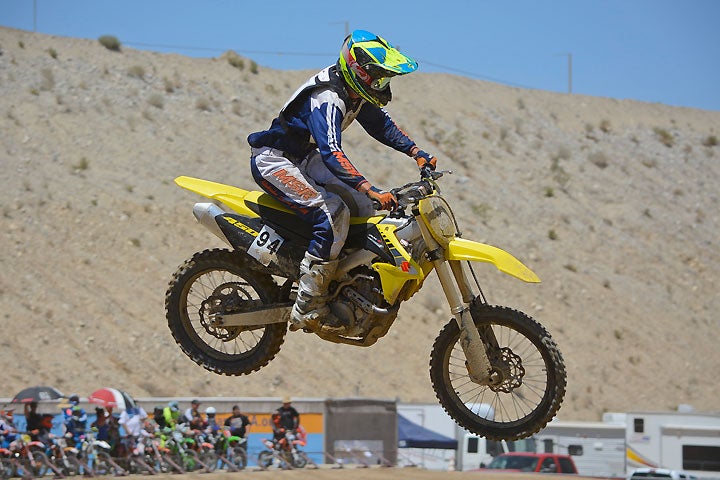
[Ringing cell phone]
“Yo.”
“Hey Scott, it’s Nic Garvin.
“I know. It said so on the caller I.D.”
“What are you doing next weekend?”
“I dunno. What are we doing next weekend?”
“Well, the last round of the AMA SoCal MX Series is happening at LACR on Sunday, and I’ve been riding that series. I’m going, and I was wondering if you wanted to go.”
“Sure. Working on my birthday sounds like a blast.”
“Ha ha. Cool, but here’s what I was wondering: At the last round I rode the YZ250F in the Pro class, and I kind of got outgunned by the 450 guys. Any chance we could get a 450 for LACR?”
“Hmm, let’s see. Abbatoye is camped out on baby watch with our YZ450F. KTM, Husky and Kawi don’t have anything available to us right now, and Honda hasn’t intro’d the new CRF450R yet. I guess that leaves the Suzuki RM-Z450.
“I’m totally cool with that. I haven’t ridden one in a while.”
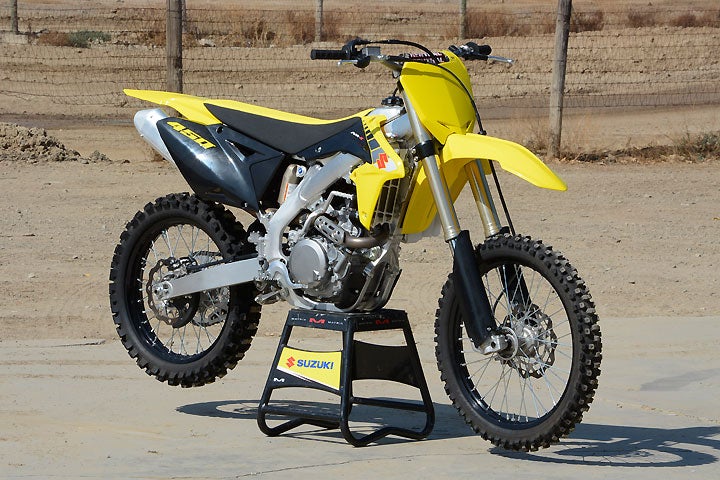
Come to think of it, neither had we, and that’s because the 2017 Suzuki RM-Z450 has been only minimally changed over the past four model years since undergoing a major redesign in 2013. The biggest change came in 2015, when Suzuki added its Suzuki Holeshot Assist Control (SHAC) system to help the vast majority of potential motocross customers get out of the gate quicker. Otherwise, Suzuki has only lightly massaged the big ‘Zook with minor ECU updates to help improve its starting, remapped its EFI to give the engine a little more punch down low, a redesigned muffler to take the edge off its exhaust note, and revisions to the SHAC.
But are we complaining? Not even a little. Because, despite its lack of updates, the RM-Z450 is a known quantity. It’s blessed with a chassis that delivers pinpoint handling, a muscular yet friendly engine performance and pretty good suspension if—and it’s a substantial if—you like air forks.
So, after a brief re-introduction to the RM-Z and some basic setup help from Suzuki PR guy Tim Olson at Milestone MX Park on Thursday, we headed to the Southern California High Desert for a weekend of berm shredding. We used Saturday to practice at our current go-to facility, Sunrise MX Park, then spent the night in Palmdale before hitting LACR for the SoCal MX finale. In addition to tackling 250 A aboard another make, Garvin chose to ride the RM-Z450 in two classes: the District King A class and the Pro class.
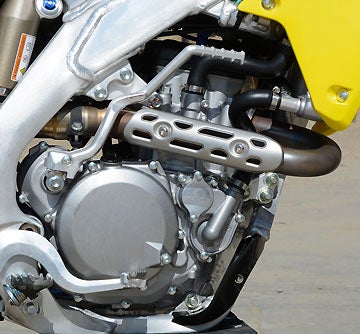
As the first District King A moto prepared to line up, Garvin was confident that he could pull the holeshot on the RM-Z450. Saturday practice had instilled that much confidence in the Suzuki’s fuel-injected DOHC Single, which attains its 449cc displacement via a 96.0 mm bore and a 62.1mm stroke—the exact same dimensions used by Honda and Kawasaki. Fueling chores are handled by a Keihin EFI system with a 44mm throttle body that features a 12-hole fuel injector.
The RM-Z’s ECU can also be quickly altered at the track by swapping among one of three power couplers that plug into the RM-Z’s wiring harness. The couplers are old news by now, but they still work well, changing them is quick and simple, and their effect is noticeable. After playing around with each one, we realized that the lean coupler actually worked best at giving the RM-Z450 the kind of low-end snap that Garvin would be looking for when the gate dropped, but if we’d had Suzuki’s accessory software, we might have tried to customize a module to our own needs—another fairly simple task. One reason we’d want to experiment is that swapping to the lean coupler makes the RM-Z way harder to start.
Sure enough, when the gate fell, Garvin and the RM-Z450 rocketed straight to the front of the field and took the early lead, thanks to the RM-Z’s potent low-end grunt and substantial mid-range thrust. We’d love to credit the Suzuki Holeshot Assist Control (SHAC) system for Garvin’s starting gate success, and in hindsight he should have used it later in the day when the track really began to dry out under the relentless beat-down it was receiving by the sun, the 100-degree temperatures and the torture of hundreds of knobby tires in race mode. However, this holeshot was obtained the old-fashioned way, with the help of the RM-Z450’s excellent-feeling clutch and smooth-shifting five-speed transmission.
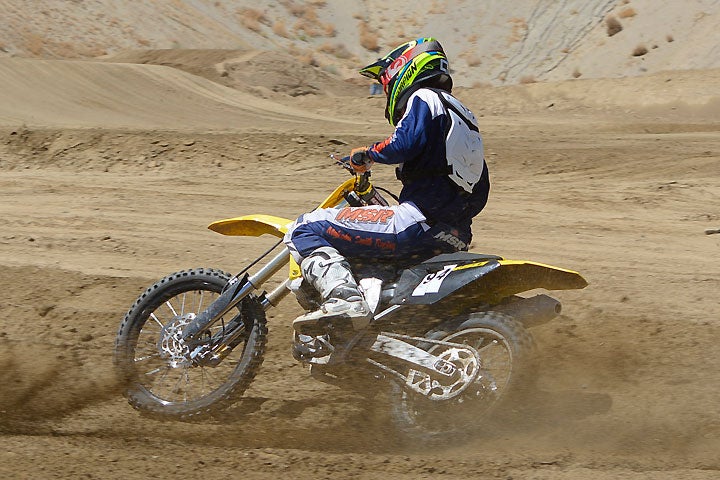
But, in case you aren’t familiar with the SHAC, here’s a refresher: The system gives the rider a choice of two modes that alter the ignition timing when engaged before the RM-Z leaves the starting line. A Mode retards the ignition timing to minimize wheel slip in hard-packed or slippery conditions, while B Mode advances the timing for high-traction conditions. After the start, the SHAC returns the ignition timing to the stock mapping in 1.2 seconds or once the rider engages third gear. The system is easily activated by a button on the left-side handlebar, and it can be completely disengaged as well. It’s a nice option to have, and we’d venture to guess that it is an advantage for a good 90 percent of RM-Z450 owners.
On the track, the RM-Z’s friendly yet forceful power delivery made an instant fan out of Garvin.
“It’s smooth all the way through,” he said. “It’s just a little soft, coming out of the gate, but once you get going it has very strong power. It’s not crazy fast, but it’s stout all the way to the rev limiter. You can be very aggressive on the throttle, and it doesn’t fall on its face. It just keeps pulling hard. I really like it. Its throttle response is good, but it isn’t as snappy as, say, the Yamaha’s fuel-injection.”
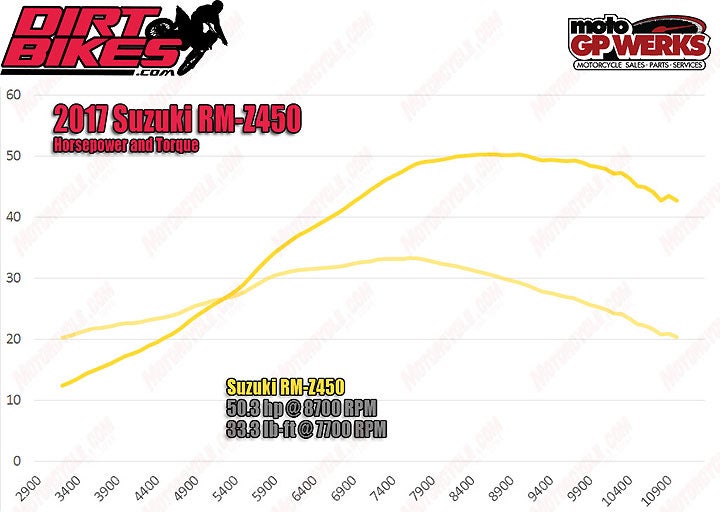
Dyno testing confirmed what Garvin was feeling, as our RM-Z450 churned out 50.3 horsepower to the rear wheel at 8700 rpm and 33.3 lb.-ft. of peak torque at 7700 rpm on Chris Redpath’s Motogpwerks.com Dynojet. The RM-Z’s linear torque curve allows it to maintain 30 lb.-ft. of torque for nearly 3000 rpm, from 5900 to 8700, and it only trails off slightly after that, maintaining a strong pull all the way to its 11,000 rpm rev limit. The RM-Z delivers solid, flexible, useable power just about everywhere in the rev range.
It’s a good thing that the 21-year-old Garvin is also flexible, as he ran up front on the first lap, but when the field came around again, he was last. He later admitted he had blown a corner at the top of the hill, executed a classic “Flying W” and gone over the bars. He was back up quickly, and the RM-Z’s excellent-handling twin-spar aluminum chassis got him back in the hunt, and he finished fifth. Later in the day, in the same class, Garvin remained crash free and pulled off a second place finish for third overall.
“It’s very stable,” Garvin said. “There is a lot of front end feel with great traction. It steers easily, and it corners really well. Overall, the bike feels a little heavy to me, but it’s still no problem putting it wherever you want. It also feels very good in the air, nice and neutral, but it’s definitely no feather.”
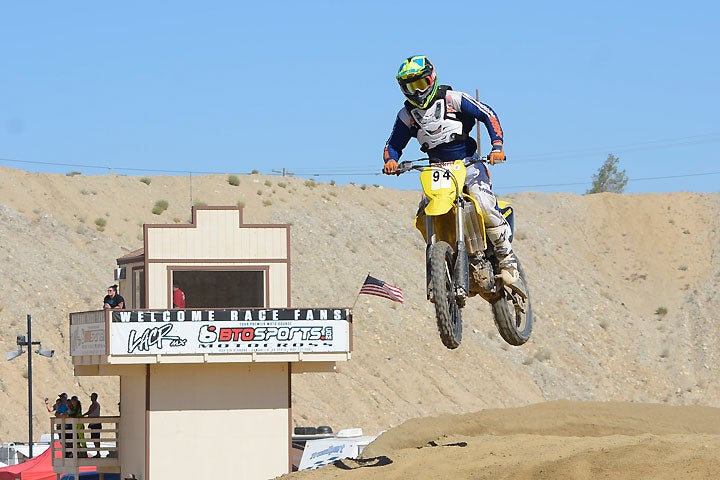
With a full load of fuel in its 1.6-gallon tank, the RM-Z tipped our scale at 245 lbs. even, placing 48.8 percent of that weight on the front wheel and 51.2 percent on the rear wheel along a 58.9-inch wheelbase. The RM-Z450’s rake is set at 28 degrees, 40 minutes.
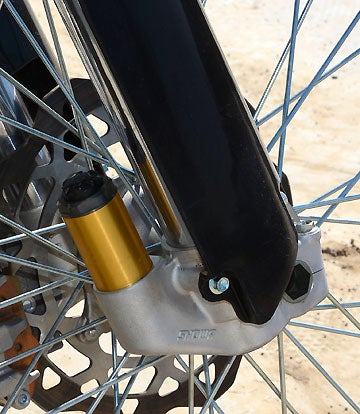
Up front, the RM-Z450 still carries a 48mm Showa SFF-Air fork that is easily recognizable by virtue of the external balance chamber located down near the front wheel on the right fork leg. Suzuki says that the triple-chamber SFF-Air fork is 2.5 pounds lighter than any spring fork and it offers easy adjustability for the rider when dialing its 12.2 inches of travel. A Showa piggyback shock, which features high- and low-speed compression damping adjustability as well as rebound damping and spring preload adjustability, resides out back. Rear wheel travel is also 12.2 inches.
After racing the RM-Z450 Garvin had mixed feelings about the Suzuki’s suspension at LACR.
“The front end is a little tricky,” he said. “If you don’t ride at a hard pace, it can feel like a brick, but the harder you ride it, the better it works. You really do have to push it, though. I have mixed feelings about the fork. I don’t hate it, but I’m not a huge fan. Just give me a spring fork because they’re so much easier to set up.”
Garvin also noted that the back tended to be a little nervous under braking.
“It isn’t a chassis thing,” he said. “I played with the clickers, but I couldn’t get the back end to settle as well as I’d like it to. It still has a little bit of a kick compared to other bikes we’ve tested lately. If you go into a rut on the brakes, you can feel it. But under acceleration and over jumps it works just fine.”
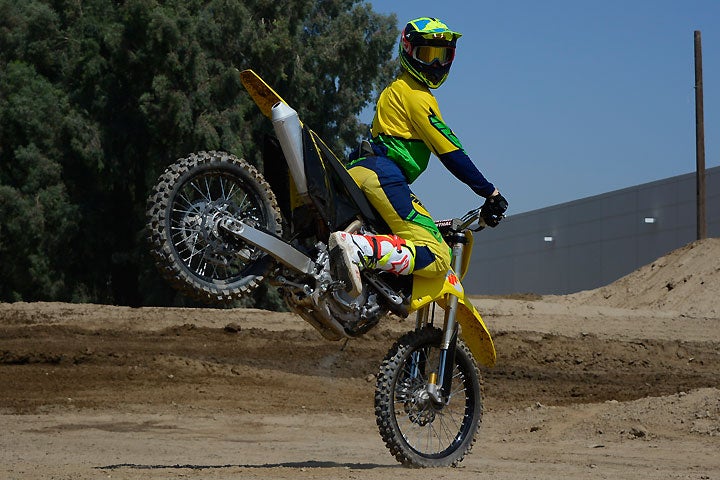
Speaking of the brakes, the RM-Z450’s 250mm front and 240mm rear wave rotor discs, clamped by Nissin calipers, may have been Garvin’s favorite attribute of the entire package.
“The brakes are just so phenomenal,” Garvin said. “The front brake is very responsive. It will literally stop on a dime. It’s amazing. The rear brake is very strong. I noticed that it never faded even as hot it as it was at LACR. I could drag it for a while, and it would stay as sensitive and strong as it was when it was cold. I think Suzuki might have the best brakes in the class. They’re better than the Yamaha or the Kawi, that’s for sure.”
Riding against some of AMA District 37’s motocross specialists was proof that Garvin, an off-road guy, was getting along just fine with the RM-Z450. Despite botching the start of the first Pro moto (“I spun up off the gate,” he said. “Oh yeah, how about that SHAC?” we said), he fought his way back up to a third-place finish, crediting the RM-Z’s chassis and ergos as a big reason for his ability to charge on the bike.
“The Suzuki’s ergos are really good for the most part,” Garvin said. “The seat isn’t too high or too low. The bar positioning is perfect. Everything is right where it should be except for the kickstarter. That thing is mounted so high that it makes it awkward when you try to get good leverage on it. But I think the chassis plays a huge role in the bike’s comfort level. It still has plenty of flex for an aluminum perimeter frame—and that’s a good thing! It’s perfect for fast and rough riding. The best way I could describe it is that it feels like a good, sturdy off-road chassis and not a narrow and stiff motocross chassis. I can’t wait to try the RMX450Z. I think it will make an amazing off-road bike!”
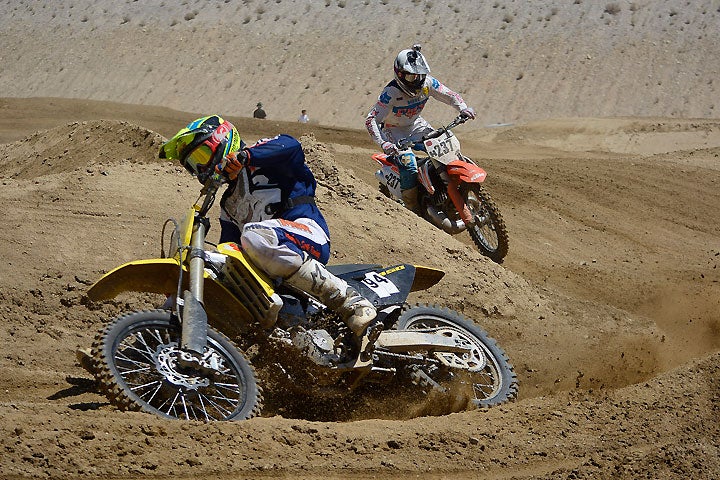
Garvin will be the first to admit that the outcome of the second Pro moto had a little more to do with bad luck by some of his competition than it did his own motocross prowess, which is nevertheless substantial. After five motos, two sets of them with very little downtime, he was admittedly a little winded as the second Pro moto unwound. However, a few bad breaks suffered by the competition allowed him to cruise to another third-place finish, which ultimately netted his best class finish of the day, second overall. That was good enough for a decent $180 return at the pay window, covering his expenses for the weekend. At the end of the day, he offered high praise for the RM-Z450.
“It’s obviously a four-year-old bike, but it’s still a really good bike, and I would rank it ahead of some of the newer bikes in the class, actually,” Garvin said. “It’s no slouch in the power department, and it more than holds its own in almost every category. When they do redesign is it, I would like to see them make a little more power, get a little weight off it and continue to refine the suspension at both ends but not hurt its overall vibe. It’s still a great motorcycle.”
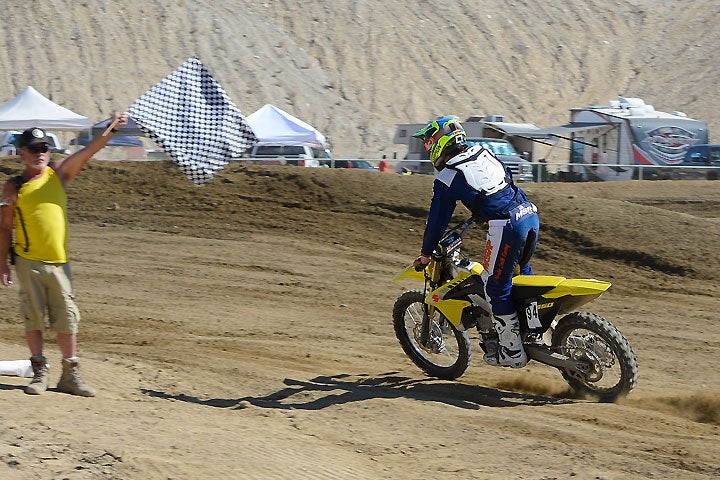
Maybe best of all, the 2017 RM-Z450 is still a great motorcycle at a great price. Checking in at $8749, it hasn’t seen a price bump in three years. Despite its maturity, it’s an excellent value in the 450cc motocross class.
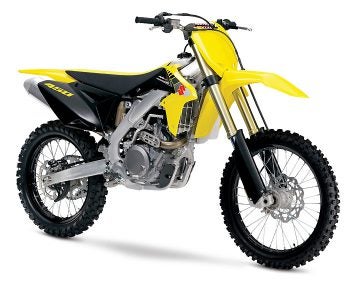 2017 Suzuki RM-Z450
2017 Suzuki RM-Z450
Specifications
MSRP: $8749
Engine
Type: 449cc, 4-stroke, liquid-cooled, single cylinder, DOHC
Bore Stroke: 96.0mm (3.78 in) x 62.1mm (2.4 in)
Compression Ratio: 12.5:1
Fuel System: Keihin fuel injection w/44mm throttle body
Starter: Primary kick
Lubrication: Semi-dry sump
Ignition: Electronic ignition (CDI)
Transmission: 5-speed constant mesh
Final Drive: Chain, DID520MXV4, 114 links
Horsepower (rear-wheel): 50.3 @ 8700 rpm
Torque: 33.3 lb.-ft. @ 7700 rpm
Chassis
Rake/Trail: 28°, 40’/NA
Overall Length: 2190 mm (86.2 in.)
Overall Width: 830 mm (32.7 in.)
Overall Height: 1270 mm (50.0 in.)
Wheelbase: 1495 mm (58.9 in.)
Ground Clearance: 325 mm (12.8 in.)
Seat Height: 955 mm (37.6 in.)
Claimed Curb Weight: 112 kg (247 lbs.)
Weight (as tested): 245.0 lbs., 118 lbs. (front)/127 lbs. (rear); 48%/52%
Suspension Front: 48mm Show SFF-Air inverted telescopic fork, fully adjustable, 12.2 inches of travel
Suspension Rear: Link type w/Showa piggyback reservoir shock, fully adjustable, 12.2 inches of travel
Brakes Front: 250mm disc brake w/twin-piston caliper
Brakes Rear: 240mm disc brake w/single-piston caliper
Tires Front: Bridgestone M403, 80/100-21 51M, tube type
Tires Rear: Bridgestone M404, 110/90-19 62M, tube type
Fuel Tank Capacity: 6.2 L (1.6 US gallons)
Color: Champion Yellow/Solid Black

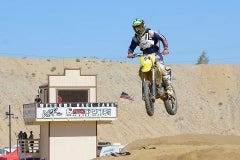
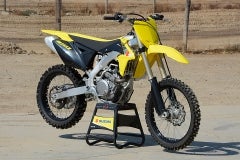
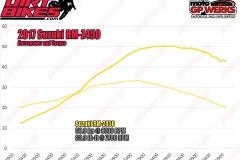
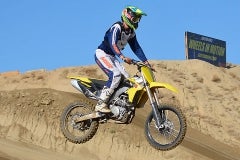
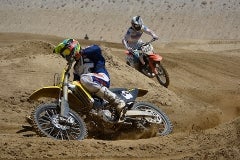
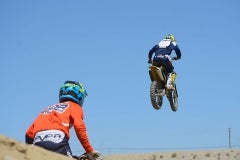
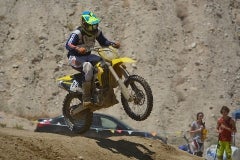
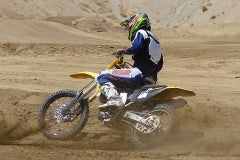
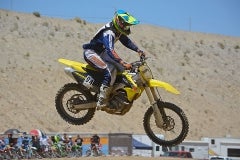
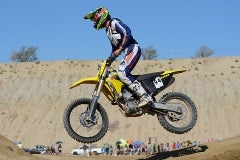
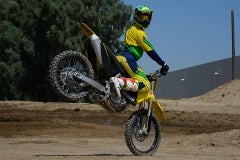

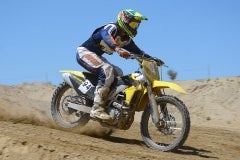
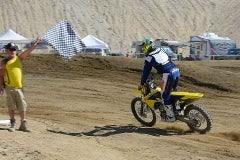
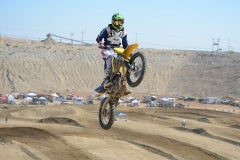
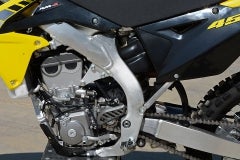
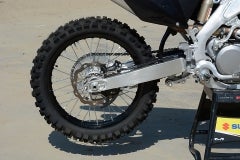
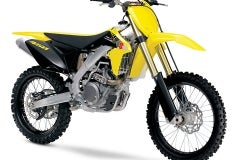
 Your Privacy Choices
Your Privacy Choices